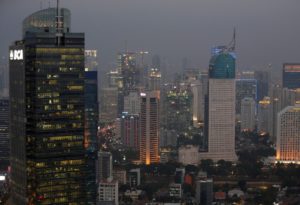
The NPL problem at Indonesia’s banks is likely to get worse, keeping economic growth below 6 percent over the coming two years as lenders hold back from boosting credit, says Destry Damayanti.
|
Jakarta, 13 Rajab 1438/10 April 2017 (MINA) – Indonesian banks are expected to be cautious boosting credit disbursement in the next couple of quarters because the non-performing loan (NPL) ratio is currently high with the gross NPL ratio hovering above 3 percent since mid-2016, approximately the same level as it was in 2011 when Indonesia’s five-year economic slowdown commenced.
Although various external and internal matters were to blame for Indonesia’s 2011-2015 economic slowdown, the high NPL ratio today can undermine economic acceleration as credit growth is curbed,indonesia-investments.com reported on Monday.
Banks in Indonesia are keeping an eye on the NPL ratio and therefore become more selective in terms of credit disbursement as a strategy to protect the quality of their loans.
Also Read: Saudi Arabia Wins Bid to Host World Expo 2030
However, this comes at the expense of higher economic growth. In 2016 credit growth in Indonesia only reached 7.9 percent year-on-year (y/y), the slowest pace since 1999, while in the decade before the banking sector had become used to double-digit growth figures.
Destry Damayanti, Commissioner at Indonesia’s Lembaga Penjamin Simpanan (Deposit Insurance Agency, abbreviated as LPS), told Bloomberg that Indonesian banks are currently eager to resolve bad debts.
Considering commodity prices remain volatile, while there is an uncertain global economic outlook, these banks do not prioritize high credit growth now. Damayanti added that the bottom for NPLs in Indonesia is yet to be seen.
Bleak credit growth in Indonesia undermines the pace of the nation’s macroeconomic growth.
Although Indonesia managed to end the five-year economic slowdown in 2016, it is still far away from Indonesian President Joko Widodo’s ambitious 7 percent (y/y) GDP growth pledge (made during his presidential campaign in 2014).
Also Read: 148 Products from Indonesia Promoted at Sarawat Superstore Jeddah
In fact, he revised his projection for Indonesia’s 2018 GDP growth to 5.6 percent (y/y) from a previous projection of a 5.4 – 6.1 percent (y/y) growth range. Thus, it should basically be impossible to see a 7 percent growth rate by 2017.
Last month Fitch Ratings also announced to maintain a negative outlook on Indonesian banks because it sees asset quality and profitability remaining under pressure in the next couple of quarters.
The credit rating agency also said it sees the NPL ratios of the larger Indonesian banks remaining at an average of 3 percent. (T/RS5/RS1)
Mi’raj Islamic News gency (MINA)
Also Read: Packaging Industry Supports Halal Ecosystem
































 Mina Indonesia
Mina Indonesia Mina Arabic
Mina Arabic